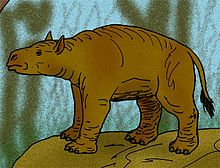| Carodnia | |
|---|---|

| |
| Carodnia vieirai | |
| Scientific classification | |
| Domain: | Eukaryota |
| Kingdom: | Animalia |
| Phylum: | Chordata |
| Class: | Mammalia |
| Order: | †Xenungulata |
| Family: | †Carodniidae |
| Genus: | †Carodnia Simpson 1935[1] |
| Species | |
| |
| Synonyms | |
|
Ctalecarodnia Simpson 1935 | |
Carodnia is an extinct genus of South American ungulate known from the Early Eocene of Brazil, Argentina, and Peru.[4] Carodnia is placed in the order Xenungulata together with Etayoa and Notoetayoa.[5]
Carodnia is the largest mammal known from the Eocene of South America. It was heavily built and had large canines and cheek teeth with a crested pattern like the uintatheres to which it can be related.[4] In life, it would have been a tapir-sized animal. It bore strong resemblances to dinoceratans, although without tusks or ossicones. When George Simpson first described Carodnia, he cited the genus name as being derived from the Tehuelche word for thunder "carodn".[6]
- ^ Carodnia in the Paleobiology Database. Retrieved May 2013.
- ^ Pierre-Olivier Antoine; Guillaume Billet; Rodolfo Salas-Gismondi; Julia Tejada Lara; Patrice Baby; Stéphane Brusset; Nicolas Espurt (2015). "A New Carodnia Simpson, 1935 (Mammalia, Xenungulata) from the Early Eocene of Northwestern Peru and a Phylogeny of Xenungulates at Species Level". Journal of Mammalian Evolution. 22 (2): 129–140. doi:10.1007/s10914-014-9278-1. S2CID 15272216.
- ^ Gelfo, J. N.; López, G. M.; Bond, M. (2024). "New insights on the anatomy, paleobiology, and biostratigraphy of Xenungulata (Mammalia) from the Paleogene of South America". Palaeontologia Electronica. 27 (2). 27.2.a30. doi:10.26879/1360.
- ^ a b "Pantodonts, uintatheres and xenungulates: The first large herbivorous mammals". Paleocene Mammals. August 2005. Retrieved 5 May 2013.
- ^ "Xenungulata". Palaeocritti. Retrieved 5 May 2013.
- ^ Simpson, George Gaylord (1935). "Descriptions of the oldest known South American mammals, from the Río Chico Formation". American Museum Novitates. Publications of the Scarritt Expeditions, no. 24 (793). hdl:2246/2125. OCLC 44083494.